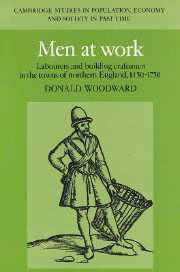Book contents
- Frontmatter
- Contents
- List of tables
- List of appendices
- Preface
- List of abbreviation
- 1 Introduction
- 2 Building craftsmen at work
- 3 The life-cycle of building craftsmen
- 4 Labourers
- 5 Conditions of work for labourers and building craftsmen
- 6 Wage rates in the northern towns
- 7 Towards an understanding of living standards
- Appendices
- Bibliography
- Index
- Cambridge Studies in Population, Economy and Society in Past Time
4 - Labourers
Published online by Cambridge University Press: 15 October 2009
- Frontmatter
- Contents
- List of tables
- List of appendices
- Preface
- List of abbreviation
- 1 Introduction
- 2 Building craftsmen at work
- 3 The life-cycle of building craftsmen
- 4 Labourers
- 5 Conditions of work for labourers and building craftsmen
- 6 Wage rates in the northern towns
- 7 Towards an understanding of living standards
- Appendices
- Bibliography
- Index
- Cambridge Studies in Population, Economy and Society in Past Time
Summary
According to an early-eighteenth-century dictionary, carpenters and other building craftsmen belonged to the ‘mechanic arts’ which ‘require more of the labour of the hand and body, than of the mind’. But labourers were engaged in ‘drudgery work’. There were times when long association with a particular type of craftsman gave a labourer some specialist skill: at a very fractious meeting of the Newcastle bricklayers' gild in 1749 a complaint was made against William Yarrow ‘for saying he had wrought at London with labourers as good workmen as any of the bricklayers in the company’. Perhaps there was much truth in the accusation, but most labourers were not specialists. However, it would be a mistake to regard them as unskilled. Their methods may often have looked rough and ready to the casual observer, but even the use of a spade or shovel involves some skill. Urban labourers differed from building craftsmen in a number of respects: they did not provide the raw materials with which they worked; they did not employ labour; and they did not usually supply their own tools. Many institutions provided basic tools such as spades, shovels, and wheelbarrows which could be used by labourers and craftsmen alike. As on building sites today the organisers of large projects bought tools in bulk. When the Hull defences were being repaired in 1577 the council purchased 120 spades, 120 shovels and 60 pickaxes, and the churchwardens of All Saints’, Newcastle, bought six eight-penny shovels for the grave digger in 1725/6.
- Type
- Chapter
- Information
- Men at WorkLabourers and Building Craftsmen in the Towns of Northern England, 1450–1750, pp. 93 - 115Publisher: Cambridge University PressPrint publication year: 1995

